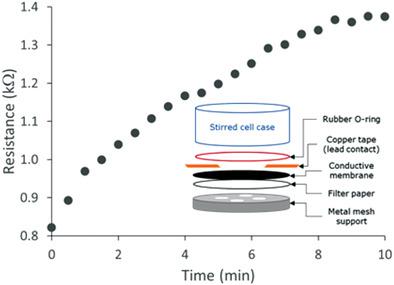当前位置:
X-MOL 学术
›
Macromol. Rapid Commun.
›
论文详情
Our official English website, www.x-mol.net, welcomes your feedback! (Note: you will need to create a separate account there.)
A Conductive Microfiltration Membrane for In Situ Fouling Detection: Proof-of-Concept Using Model Wine Solutions.
Macromolecular Rapid Communications ( IF 4.6 ) Pub Date : 2020-08-07 , DOI: 10.1002/marc.202000303 Sheung-Yin Li 1, 2 , Benjamin S Schon 3 , Jadranka Travas-Sejdic 1, 2
Macromolecular Rapid Communications ( IF 4.6 ) Pub Date : 2020-08-07 , DOI: 10.1002/marc.202000303 Sheung-Yin Li 1, 2 , Benjamin S Schon 3 , Jadranka Travas-Sejdic 1, 2
Affiliation

|
Cross‐flow microfiltration, using a microporous membrane, is a well‐established technique for wine clarification in oenology because of its cost‐effectiveness and high‐throughput. However, membrane fouling remains a significant issue for wine filtration in high‐throughput systems. Herein, an approach for in situ real‐time monitoring of fouling in filtration systems using a conductive filtration membrane and a model fluid for filtration is reported. The membrane is fabricated by embedding poly(3,4‐ethylenedioxythiophene) into an electrospun sulfonated polystyrene‐block‐poly(ethylene‐ran‐butylene)‐block‐polystyrene microporous membrane, producing a conductive microfiltration membrane. Measurement of the resistance of the conductive membrane during filtration with the fouling solutions containing pectin, as one of the major foulants in unfiltered wine and pre‐fermentation grape juice, shows a time‐ and concentration‐dependent response. This work opens a door to new methodology for in situ monitoring of fouling processes in wine and juice filtration systems.
中文翻译:

用于原位结垢检测的导电微滤膜:使用模型葡萄酒解决方案的概念验证。
使用微孔膜的错流微滤是一种在酿酒学中用于葡萄酒澄清的成熟技术,因为它具有成本效益和高通量的特点。然而,在高通量系统中,膜污染仍然是葡萄酒过滤的重要问题。本文中,报告了一种使用导电滤膜和用于过滤的模型流体实时实时监控过滤系统中结垢的方法。该膜通过嵌入聚(3,4-亚乙基)转换为电纺丝制造的磺化聚苯乙烯-嵌段-聚(乙烯- RAN丁烯) -嵌段-聚苯乙烯微孔膜,产生导电性微滤膜。在含有果胶的污垢溶液(未过滤的葡萄酒和发酵前的葡萄汁中的主要污垢之一)下,过滤过程中导电膜的电阻测量显示出时间和浓度依赖性。这项工作为葡萄酒和果汁过滤系统中结垢过程的现场监测新方法学打开了一扇门。
更新日期:2020-09-22
中文翻译:

用于原位结垢检测的导电微滤膜:使用模型葡萄酒解决方案的概念验证。
使用微孔膜的错流微滤是一种在酿酒学中用于葡萄酒澄清的成熟技术,因为它具有成本效益和高通量的特点。然而,在高通量系统中,膜污染仍然是葡萄酒过滤的重要问题。本文中,报告了一种使用导电滤膜和用于过滤的模型流体实时实时监控过滤系统中结垢的方法。该膜通过嵌入聚(3,4-亚乙基)转换为电纺丝制造的磺化聚苯乙烯-嵌段-聚(乙烯- RAN丁烯) -嵌段-聚苯乙烯微孔膜,产生导电性微滤膜。在含有果胶的污垢溶液(未过滤的葡萄酒和发酵前的葡萄汁中的主要污垢之一)下,过滤过程中导电膜的电阻测量显示出时间和浓度依赖性。这项工作为葡萄酒和果汁过滤系统中结垢过程的现场监测新方法学打开了一扇门。



























 京公网安备 11010802027423号
京公网安备 11010802027423号